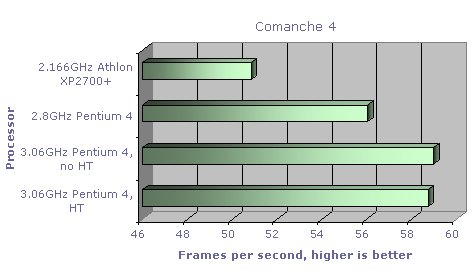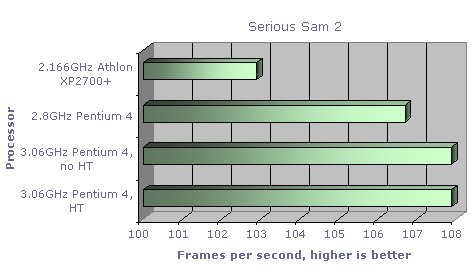|
Benchmarks III
Comanche 4 next and it'll be interesting to see what happens on this traditionally CPU and subsystem limited test.
 CPU scaling and another small decrease with HyperThreading
CPU scaling and another small decrease with HyperThreading
Again, another candidate that doesn't benefit from HyperThreading. We are seeing resource contention here on the processor with HyperThreading enabled. Maybe the code within Comanche 4 can be tuned to have less resource contention on a HyperThreaded processor but at the moment, that's not the case.
Serious Sam 2 now, expect to see the same sort of thing.
 CPU scaling and another small decrease with HyperThreading
CPU scaling and another small decrease with HyperThreading
Again, the code and data layout on our game stops HyperThreading having any good effects. It's not a performance killer however, just no performance increase. Again, resource contention on the processor stops HyperThreading giving a boost. Games in general are never optimised for SMP on Windows systems with Quake3 being the only game I can remember to do such a thing.
More hugely impressive performance from a Pentium and PC1066 RDRAM combination with 500 frames per second coming up on the board without any problem. HT offers us no increase in performance for the reasons outlined already. One interesting thing to note is that explicitly enabling Quake3's SMP support by setting r_smp to 1 via the console and issuing a vid_restart while HyperThreading was enabled caused Quake3 to become completely unresponsive. It was possible to close Quake3 using task manager but it wouldn't complete a benchmark with r_smp 1 and HyperThreading enabled.
One final test to show off the strength of HyperThreading given the right conditions. The standard Hexus benchmark suite doesn't really show you where the new technology can stretch its legs so here's something a bit more interesting and more in tune with where you'll see benefits.
So we're doing the stock Hexus DivX encoding test with the first VOB of Gone In Sixty Seconds at 1.8KBit/sec encoding rate using VirtualDub to drive the DivX 4.12 codec. However this time we'll loop the AVG Antivirus Complete Test in the background which does mammoth amounts of file I/O to check your system for infection. Running both in parallel should let you see where HT's performance advantage lies. In our original DivX test, HyperThreading gives us a 7.5% performance boost so lets see what HT gives us here.
So while we have the obvious slowdown in encoding speeds, it's the margin of performance increase that's interesting. This time we gain over 12% on the non HyperThreading score. It's this kind of multithreaded test with lots of sequential I/O on the CPU that gives our HyperThreading benefits. While our Hexus suite doesn't really show it off like Intel would like us to, this test shows you how to make it work hard and get some good performance.
|